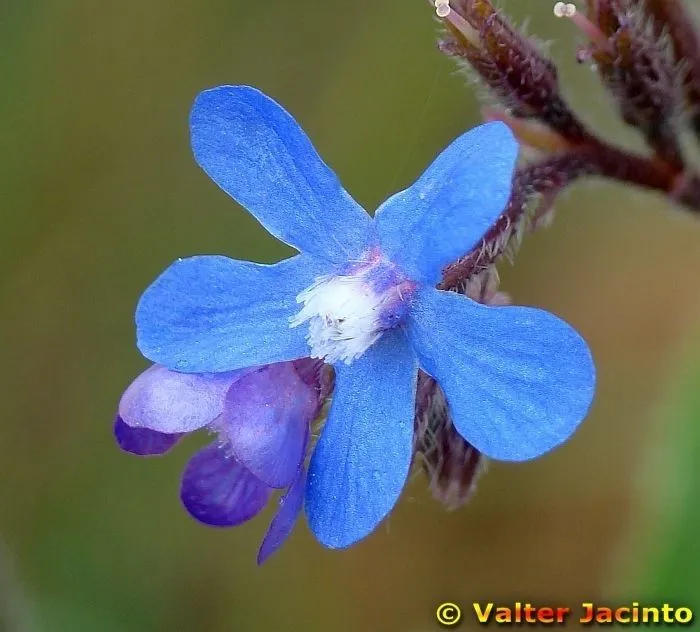
Author: Mill.
Bibliography: Gard. Dict. ed. 8.: n.° 9 (1768)
Year: 1768
Status: accepted
Rank: species
Genus: Anchusa
Vegetable: Unknown
Observations: EC. Europe to Medit. and W. Himalaya
The garden anchusa, scientifically known as Anchusa azurea, is a captivating perennial belonging to the Boraginaceae family. Gifted with striking deep blue flowers, it serves as an eye-catching addition to any garden landscape. This plant, which was first documented in the 8th edition of the “Gardener’s Dictionary” in 1768 by Mill., has long been admired for its ornamental value and vibrant display.
Garden anchusa is native to extensive regions ranging from Eastern and Central Europe to the Mediterranean and the Western Himalayas. This broad geographic spread indicates the plant’s adaptability to various climates and soils, making it a versatile choice for gardeners worldwide.
Characterized by its tall, bristly stems that can reach heights of up to 1.2 meters, Anchusa azurea showcases clusters of intensely blue, tubular flowers that bloom from late spring to early summer. The foliage consists of lance-shaped, rough leaves that provide a distinct texture contrast in mixed borders and wildlife gardens.
Beyond its ornamental beauty, Anchusa azurea plays a vital role in supporting pollinators. The flowers are particularly attractive to bees and butterflies, thus contributing to the ecological well-being of garden ecosystems. Moreover, due to its extensive root system and robust growth, it can help stabilize soils and prevent erosion, making it a valuable plant for sustainable gardening practices.
Cultivating garden anchusa is relatively straightforward. It prefers full sun to partial shade and thrives in well-draining soil. While it is moderately drought-tolerant once established, regular watering during prolonged dry periods will ensure more vigorous growth and prolonged blooming.
For those interested in integrating this hardy perennial into their garden, it is worth noting that it can be propagated by seed, division, or cuttings. Spring or autumn is the ideal time for planting, allowing the roots to establish well before the extremes of summer or winter.
In summary, Anchusa azurea is not only a visual delight with its vivid blue blossoms but also a practical addition to the garden, contributing both to biodiversity and soil health. Its historical recognition and broad geographical presence underscore its enduring appeal and adaptability in various horticultural settings.
Dan: blomme, italiensk oksetunge, kræge, pære
Eng: garden anchusa, italian alkanet, italian bugloss, large blue alkanet, italian anchusa
Deu: italienische ochsenzunge
Nor: kreke, plomme, pæretre
Fin: kriikunapuu, luumupuu, päärynäpuu
Swe: krikon, plommon, päron, virginiahägg, italiensk oxtunga
Spa: lengua de buey
Fra: buglosse d’italie
Ces: pilát modrý
Nld: blauwe ossentong
Cym: llysiau’r-gwrid glas
En: Garden anchusa, Large blue alkanet, Italian alkanet, Italian bugloss, Alkanet forget-me-not, Italian anchusa
Af: Europese ossetong
Ar: لسان الثور الأزرق
Hy: Կավաժիպակ իտալական
Az: İtaliya sümürgəni
Eu: Idi-mihi
Bg: Италианско винче
Ca: Buglossa, Buglossa blava, Llengua bovina
Zh: 天蓝牛舌草, 牛舌草
Hr: Modri volujak
Cs: Pilát modrý
Da: Italiensk oksetunge, Blomme, Kræge, Pære
Nl: Blauwe ossentong, Blauwe Ossetong
Fi: Sinirasti, Kriikunapuu, Luumupuu, Päärynäpuu
Fr: Buglosse d’Italie, Buglosse azurée, Bourrache bâtarde, Fausse Bourrache
Ka: Პატარძალა
De: Italienische Ochsenzunge
He: לשון-פר איטלקית
It: Buglossa azzurra, Lingua di bue, Lingua di manzo
No: Kreke, Plomme, Pæretre
Fa: آنچوسا آزورا
Pl: Farbownik lazurowy
Pt: Língua-de-vaca
Ru: Воловик итальянский
Sk: Smohla talianska
Es: Lengua de buey, Lenguaza
Sv: Italiensk oxtunga, Krikon, Plommon, Päron, Virginiahägg
Zh-tw: 天藍牛舌草
Tg: Говзабон
Zh-hant: 牛舌草
Uk: Воловик темно-блакитний
Uz: Govzabon
Cy: Llysiau’r-gwrid glas
© copyright of the Board of Trustees of the Royal Botanic Gardens, Kew.
© copyright of the Board of Trustees of the Royal Botanic Gardens, Kew.
© copyright of the Board of Trustees of the Royal Botanic Gardens, Kew.
Taken Mar 25, 2007 by EOL − Valter Jacinto (cc-by-nc-sa)
Taken Aug 4, 2020 by Elebal MN (cc-by-sa)
Taken Apr 11, 2007 by EOL − Luigi Rignanese (cc-by-nc)
Taken Apr 27, 2019 by kamel kamel (cc-by-sa)
Taken Mar 7, 2010 by EOL − Valter Jacinto (cc-by-nc-sa)
Taken Apr 11, 2007 by EOL − Luigi Rignanese (cc-by-nc)
Taken Apr 11, 2007 by EOL − Luigi Rignanese (cc-by-nc)
Taken Apr 17, 2020 by 23 maxxx (cc-by-sa)
Taken Jun 1, 2020 by raph (cc-by-sa)
Taken Apr 29, 2018 by Adil Adil (cc-by-sa)
Taken May 31, 2019 by Pierluigi Astrologo (cc-by-sa)
Taken Apr 29, 2021 by Ruiz Nuria (cc-by-sa)
Taken Jun 1, 2020 by raph (cc-by-sa)
Taken Apr 11, 2022 by Paolo Musetti (cc-by-sa)
Taken Mar 9, 2021 by Melissa Nikolaou (cc-by-sa)
Taken Apr 25, 2021 by NUMIDIA Aksil (cc-by-sa)
Taken Apr 11, 2007 by EOL − Luigi Rignanese (cc-by-nc)
Family: Myrtaceae Author: (F.Muell.) K.D.Hill & L.A.S.Johnson Bibliography: Telopea 6: 402 (1995) Year: 1995 Status:…
Family: Rubiaceae Author: Pierre ex A.Froehner Bibliography: Notizbl. Bot. Gart. Berlin-Dahlem 1: 237 (1897) Year:…
Family: Sapindaceae Author: Koidz. Bibliography: J. Coll. Sci. Imp. Univ. Tokyo 32(1): 38 (1911) Year:…
Family: Asteraceae Author: A.Gray Bibliography: Pacif. Railr. Rep.: 107 (1857) Year: 1857 Status: accepted Rank:…
Family: Fabaceae Author: Medik. Bibliography: Vorles. Churpfälz. Phys.-Ökon. Ges. 2: 398 (1787) Year: 1787 Status:…
Family: Aspleniaceae Author: (Cav.) Alston Bibliography: Bull. Misc. Inform. Kew 1932: 309 (1932) Year: 1932…